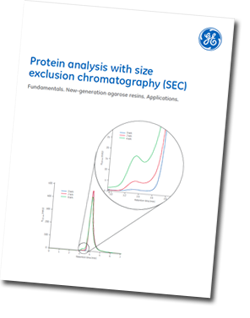Want to read a great introduction to SEC for protein analysis, and the advantages of new-generation agarose columns - then take a look at this new white paper from GE Healthcare.
 Size exclusion chromatography (SEC) is currently the most powerful chromatography technique for obtaining reliable information about the size of biomolecules under native conditions. As such, it is widely used in several different analytical applications from basic research to quality control of biotherapeutics. Available from GE Healthcare is a white paper presenting fundamentals about analytical SEC and describing how new-generation agarose-based SEC columns are used in analysis of biomolecules.
Size exclusion chromatography (SEC) is currently the most powerful chromatography technique for obtaining reliable information about the size of biomolecules under native conditions. As such, it is widely used in several different analytical applications from basic research to quality control of biotherapeutics. Available from GE Healthcare is a white paper presenting fundamentals about analytical SEC and describing how new-generation agarose-based SEC columns are used in analysis of biomolecules.

Since the introduction of biologic-based therapeutics, the need for checking the presence of protein aggregates has been of particular concern given their potential effect on efficacy and immunogenicity. SEC is a very effective method for protein analysis and it allows true size profiling of protein samples due to the mild separation conditions that can be used to obtain high-resolution separations. This is a great advantage compared to other size-separation techniques, such as ultrafiltration or dialysis. A protein can occur in different “size forms” and those different forms exhibit different functions. As many protein “size forms” are held together by noncovalent means, they are often weak and could be easily broken if using nonnative (i.e., denaturing) conditions.
The use of SEC makes it possible to size profiling the sample, for example when you need to:
- Monitor protein prep quality
- Evaluate protein stability
- Study complex formation
- Evaluate tendency to aggregate and quantity of aggregates
- Evaluate tendency to degrade and quantity of degraded forms
- Identify protein interaction partners and interaction conditions
When choosing SEC columns for protein analysis many parameters need to be considered with resolution being one of the most important. Resolution is influenced by several factors including:
- Resin properties
- Column related factors
- Running conditions
- LC system configuration
To find out more about new-generation agarose columns, their benefits and applications in protein analysis click on the button below...




